Don't wanna be here? Send us removal request.
Text
Top 10 Container Terminal Operating Systems: Enhancing Efficiency in Modern Ports
With increasing global trade and greater complexity within the maritime logistics sector, ports and terminal operators turn to advanced terminal operating systems to work more efficiently. A terminal operating system is the core of container terminal management software, working as a workstation through which the digital control of container terminal operations can be carried out efficiently.
This article covers the top 10 container terminal operating systems along with their key features, benefits, services, support, deployment options, and cost considerations. All of these solutions interface with the bigger terminal automation systems and are extremely relevant for ports seeking further digital transformation.
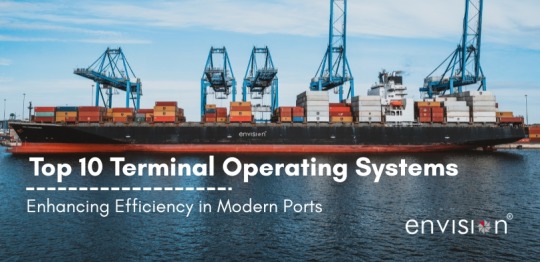
Navis N4
Navis N4 by Navis is one of the most trusted and widely implemented container terminal operating systems globally. It supports terminals of all sizes and integrates effortlessly with other terminal solutions.
Why It's Among the Best:
Innovation, reliability, and scalability-More so container terminal operations have enjoyed these traits attributed to Navis N4 since its inception. In the Navy Computer Corps, decision-making in real-time and timely support for automation have always been some of the very attributes of an industry standard.
Core Functionalities:
Centralized terminal management software
Integrated vessel planning and optimization
Real-time yard truck management system support
Robust container tracking software
Benefits:
Maximizes throughput and equipment utilization
Enhances operational visibility and decision-making
Supports integration with terminal automation systems and automated gate systems
Services and Support:
Navis offers full-scale implementation support, technical consultation, and 24/7 global support. They also provide training and regular software updates.
Deployment and Technology:
Navis N4 supports both cloud-based and on - premise deployments with modular scalability.
Cost Consideration:
Pricing depends on terminal size, modules selected, and level of customization.
Tide works Technology Mainsail Vanguard
Tide works' Mainsail Vanguard is a powerful container terminal software suite known for its flexibility and scalability across multi-terminal facilities.
Why It's Among the Best:
It combines intuitive design with enterprise-grade performance, offering modular options tailored to both smaller terminals and large, multi-user environments.
Core Functionalities:
Real-time operational dashboards
Seamless container yard management system
Interfacing with external systems and third-party tools
Benefits:
Increased transparency and control
Optimized yard operations and terminal productivity
Efficient multi-terminal management
Services and Support:
Includes on-site implementation, dedicated account management, technical training, and round-the-clock technical support.
Deployment and Technology:
Offered as both cloud and server-based solutions with scalable architecture.
Cost Consideration:
Competitive pricing model based on system scope and implementation scale.
Kalmar One
Kalmar One is a comprehensive and modular terminal management system that offers complete automation and equipment integration solutions.
Why It's Among the Best:
Its modular nature allows terminals to implement only the components they need, reducing cost and improving efficiency.
Core Functionalities:
Integrated with container freight station (CFS) software
Support for automated gate system
Modular depot management system (DMS)
Benefits:
Streamlined automation processes
Improved ROI on container terminal automation investments
Scalable from single terminal to global operations
Services and Support:
Global deployment services, maintenance contracts, 24/7 technical assistance, and strategic consultation.
Deployment and Technology:
Supports hybrid deployments with cloud integrations and equipment-level automation.
Cost Consideration:
Modular pricing based on selected features and equipment compatibility.
Cyber Logitech OPUS Terminal
Cyber Logitech’s OPUS Terminal is a next-generation TOS designed to support intelligent operations for container terminals.
Why It's Among the Best:
It enables full-stack container terminal management through integration with IoT, AI, and big data analytics.
Core Functionalities:
Real-time planning and execution tools
Vessel planning and optimization modules
Intelligent yard and berth planning
Benefits:
Enables proactive management of terminal resources
Reduces equipment idle time and energy usage
Scalable and modular architecture
Services and Support:
Offers professional consulting, remote and on-site support, and regular system upgrades.
Deploypment and Technology:
Built on a flexible architecture compatible with both cloud and on - premise environments.
Cost Consideration:
Pricing is dependent on terminal size, desired integrations, and volume throughput.
Envision CTOS by Envision Enterprise Solutions
Envision CTOS is a robust and customizable container terminal operating system developed by Envision Enterprise Solutions. It provides a holistic terminal management system POS platform that supports complex container terminal operations with a strong emphasis on automation, scalability, and adaptability.
Why It's Among the Best:
The key promise of Envision CTOS is that it features an outstanding degree of versatility when dealing with the different types of container terminal operation, such as small regional ports as well as large international gateways. The system is even more configured to be invariably compatible with the total terminal automation area which will lead to digital transformation at all levels of terminal operations.
Core Functionalities:
Integrated container yard management system and container freight station (CFS) software
Real-time terminal solutions and operations monitoring
Scalable multi-terminal architecture and customizable workflows
Seamless compatibility with automated gate systems, yard truck management systems, and depot management system (DMS)
Benefits:
Streamlines operations and minimizes downtime
Future-proof infrastructure with AI-driven analytics
Superior adaptability to specific client needs
Services and Support:
Envision Enterprise Solutions offers end-to-end support including system implementation, user training, 24/7 technical assistance, and custom solution design. Their strong service model ensures that container terminal operators can deploy and operate Envision CTOS with confidence.
Deployment and Technology:
Envision CTOS, constructed on a versatile cloud-based and on location deployment basis, is hybrid-environment-friendly to offer the best reliability. The system combines an AI-based analytics and a container tracking software to help it make improved decisions and operate more efficiently.
Cost Consideration:
Competitive pricing with customizable licensing models based on terminal needs.
TOS+ by RBS
TOS+ by RBS (Real time Business Solutions) is a cloud-native TOS designed for high-performance container terminal operations.
Why It's Among the Best:
TOS+ stands out for its real-time functionality and ease of use, suitable for both large-scale and mid-size terminals.
Core Functionalities:
Integrated modules for quay, yard, gate, and rail operations
Support for container tracking software
Real-time decision engine and predictive analytics
Benefits:
Cloud-native architecture reduces infrastructure cost
User-friendly interface for faster onboarding
Enhanced automation readiness
Services and Support:
RBS provides full project management, implementation services, ongoing training, and 24/7 technical support.
Deployment and Technology:
Offered as a Software-as-a-Service (SaaS) platform with real-time cloud synchronization.
Cost Consideration:
Subscription-based model with flexible pricing tiers.
Inform Logistics SyncroTESS
Inform’s SyncroTESS is a decision support system that enhances terminal operations through AI-driven analytics.
Why It's Among the Best:
SyncroTESS empowers operators with predictive insights, helping optimize equipment usage and terminal layout.
Core Functionalities:
Advanced optimization algorithms
Seamless container yard management system
AI-powered resource scheduling
Benefits:
Reduces operational bottlenecks
Enhances overall container terminal software performance
Predictive accuracy reduces delays
Services and Support:
Provides technical workshops, integration services, and on-call support packages.
Deployment and Technology:
Can be deployed as a stand-alone engine or integrated with an existing TOS.
Cost Consideration:
Custom pricing based on integration level and system scope.
Konecranes TBA Autostore
Auto store by Konecranes TBA is an automation-centric TOS that combines software intelligence with operational efficiency.
Why It's Among the Best:
Autostore leverages simulation and modeling to increase container terminal automation throughput.
Core Functionalities:
Automation-friendly container terminal management system
Advanced simulation for process testing
AI-enabled container tracking software
Benefits:
Reduces handling errors
Increases automation ROI
Lowers operational expenditure
Services and Support:
Includes remote monitoring, training, and technical onboarding.
Deployment and Technology:
Offered with a hybrid deployment model, with simulation tools available on-demand.
Cost Consideration:
High initial setup with scalable pricing for modules.
Jade Master Terminal
Jade Master Terminal is tailored for mixed cargo terminals, combining general and containerized cargo operations.
Why It's Among the Best:
Its all-in-one approach is ideal for ports handling a variety of cargo types without compromising efficiency.
Core Functionalities:
Unified terminal operations software
Dynamic reporting and real-time dashboards
Container yard and vessel planning modules
Benefits:
Simplifies complex cargo workflows
Increases port productivity
Excellent for regional or developing ports
Services and Support:
Comprehensive deployment support and user training, with local partner availability.
Deployment and Technology:
Cloud-enabled with easy-to-integrate APIs.
Cost Consideration:
Affordable pricing for small and mid-sized terminals.
Zebra FX Collect Terminal OS
Zebra FXCollect is a cutting-edge container terminal operating system focused on real-time asset visibility through IoT and RFID.
Why It's Among the Best:
It combines rugged hardware with intuitive software to deliver a high-visibility terminal environment.
Core Functionalities:
Real-time data collection via RFID and IoT
Integrated with depot management system (DMS)
Automated gate system support
Benefits:
Enhances cargo traceability
Improves inventory and logistics control
Minimizes operational risk
Services and Support:
Zebra provides end-to-end support including device integration, remote maintenance, and custom development.
Deployment and Technology:
IoT-driven hybrid platform with scalable cloud support.
Cost Consideration:
Hardware and software bundled or separately priced based on scale.
Conclusion:
The decision on selecting the container terminal operating system can no longer be regarded as an issue of operational comfort, but rather a mission-critical undertaking that has the direct impact on the efficiency, safety, and long-term competitiveness of a particular port. The most effective TOS platforms on the market nowadays provide a full range of advanced features, such as yard truck management systems, vessel planning applications, container tracking software, and even automated gate systems, designed to make the process as efficient and informed as possible.
The ten terminal operating systems which have been examined in this guide provide the cutting edge of technology of port logistics throughout the world. However, the outstanding flexibility, rich functionality, and prospective design of the Envision CTOS make it stand alone amid the rest. Designer to support large scale terminals and regional properties alike, EnvisionCTOS is designed to connect with the terminal automation system you presently use to have full control of all aspects of your container terminal activities.
No matter whether you intend to replace an aged infrastructure model or completely switch to an automated workflow process, Envision CTOS can be your preferred choice in how to go about digital transformation. It has a modular design, backed by exceptional industry support, thus it can be easily deployed, scaled and future-proof.
Move one step forward to the operational excellence. To learn more, and to request a custom demo, get in touch with Envision Enterprise Solutions today to discuss deployment options, and understand how Envision CTOS can support your terminal on its journey into the next generation of smart automation.
#container terminal operating system#multi cargo terminal operating system#terminals#envision enterprise solutions#container shipping#vessel planning and optimization#ctos#container freight station (cfs) software#ai powered port management#ports community management#container tracking software
0 notes
Text
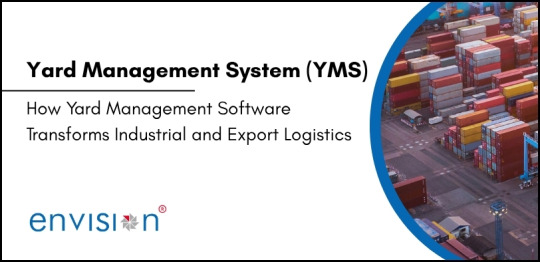
What is Yard Management, and Why Does It Matter?
Yard management involves the efficient moving and staging of trailers, containers, trucks, and other vehicles inside the yards of warehouses, distribution centers, manufacturing plants, and ports. While some digitization has taken place in warehouse and transportation operations for some decades, the remaining majority of yards continue to remain manual, paper-and-pencil sorts of operations rendering them inefficient and delayed with added costs of operation.
This is where a yard management system (YMS) comes into play. A YMS enables real-time tracking, automation of gate processes, and better scheduling, thereby transforming the yard from a black hole of inefficiency into a strategic asset. Whether it's a retail distribution hub, a freight terminal, or an inland container depot, yard management software ensures maximum productivity.
#container terminal operating system#ai powered port management#ports community management#multi cargo terminal operating system#terminals#container freight station (cfs) software#envision enterprise solutions#vessel planning and optimization#container shipping#yard#yard management
0 notes
Text
#container terminal operating system#ports community management#multi cargo terminal operating system#ai powered port management#terminals#container freight station (cfs) software#envision enterprise solutions#vessel planning and optimization#container shipping#Envision GTOS
0 notes
Text
CTOS in Maritime Logistics: Empowering World Trade through Intelligent Terminal Automation
Introduction
In the rapidly changing world of international logistics, port terminals hold critical importance in ensuring the smooth flow of goods. With container volumes accelerating exponentially, the demand for smart digital solutions has become utmost. At the core of this revolution is the Container Terminal Operating System (CTOS) — an end-to-end digital solution aimed at easing and automating container terminal operations.
With growing pressures to maximize workflows, turnaround times, and visibility, CTOS products such as Envision CTOS are becoming the go-to solutions in the shipping industry. They are designed to support sophisticated terminal operations, converge diverse functions including container yard management system, yard truck management system, depot management system (DMS), and container freight station (CFS) software, with enhanced performance, compliance, and scalability.

This blog delves into the significance of CTOS, major trends in its development, the international influence of digital terminals, the variety of services it offers, and an in-depth analysis of its features, advantages, and accomplishments of Envision CTOS.
Significance of CTOS in Container Terminals
The Container Terminal Operating System (CTOS) is the digital mind of an efficient port terminal. It facilitates smooth coordination among different parties, assets, and processes with minimal human intervention and less chance of error, while maximizing operational efficiency.
Why CTOS is vital
Enhanced visibility: Through real-time information on the status of containers, equipment position, and truck movement, CTOS heightens visibility across the terminal.
Higher productivity: CTOS eliminates the redundancy of repetitive functions such as gate entries, stack operations, and resource scheduling for quicker throughput.
Lower costs: Optimized manning, fewer idle hours, and the reduction of paperwork through CTOS minimize operational expenses substantially.
Regulatory compliance: The CTOS system is configured to comply with worldwide customs, safety, and environment regulations.
Improved decision making: Real-time insights and past performance data allow better planning and decision-making based on data.
Modules such as the automated gate system, container tracking software, and equipment tracking tools make sure that all the movement in the terminal is traced and optimized.
Future Trends in CTOS
The future of terminal operations rests on container terminal automation, and advanced CTOS platforms are transforming rapidly to adapt to the changing needs of the industry.
Smart Automation and Robotics
Increasing numbers of terminals are investing in yard truck management systems, automated cranes, and robotic process automation. These intelligent systems complement the container yard management system to automate the processing of thousands of containers per day.
AI-Powered Resource Planning
Artificial Intelligence and Machine Learning algorithms integrated in CTOS platforms such as Envision CTOS are transforming resource planning. AI assists in predicting vessel arrivals, peak times, and labor requirements to optimize manning and equipment utilization.
Cloud-Based CTOS Architecture
Cloud deployment of CTOS platforms provides scalability, reduced IT overhead, and remote access ease. Terminals are now able to roll out services like container tracking software and performance reporting to global locations instantly.
Integration with Blockchain
In order to provide transparency, security, and traceability, CTOS systems are integrating with blockchain networks. This supports tamper-proof record-keeping and enhanced regulatory compliance.
Sustainability and Green Port Initiatives
New generation CTOS platforms are supporting environmental sustainability. Components such as equipment tracking and fuel usage analytics are reducing carbon footprints and facilitating cleaner port operations.
Improved Gate and Yard Management
Both gate and yard management modules are now an integral part of enhanced CTOS platforms. These optimize the flow of trucks, equipment, and containers around the terminal.
Global Reach of CTOS
The reach of the Container Terminal Operating System (CTOS) is international. Regardless of whether they are located in North America, Europe, Asia, or Africa, ports are using CTOS to drive performance, eliminate bottlenecks, and stay competitive.
Improved Trade Flow
CTOS minimizes vessel dwell time and enhances container throughput, thereby enabling quicker trade cycles. Intelligent terminals with container terminal automation and vessel planning and optimization software are creating new standards in trade efficiency.
Economic Growth and Job Creation
Optimized port operations stimulate regional economies, increase trade competitiveness, and generate high-skilled jobs in IT, automation, and logistics management.
Standardization and Compliance
CTOS facilitates regulatory compliance with international standards such as IMO, ISPS, and custom practices, for more seamless cross-border transactions.
Digital Transformation Across Supply Chains
Through connecting CTOS with logistics partners, custom systems, and inland terminals through depot management systems (DMS) and CFS software, all phases of the cargo cycle become digital and traceable.
Real-Time Operational Intelligence
Sophisticated container tracking software, performance reporting, and equipment tracking give terminals real-time visibility to enable them to respond quicker and schedule more efficiently.
Core Services Offered by CTOS
A solid Container Terminal Operating System offers an integrated set of services that span all terminal operations. These services are at the heart of the functionalities of a smart port:
Container Yard Management System
This module controls all activities in the container yard, such as stacking, retrieval, inventory control, and space allocation. It ensures efficient yard planning, improves operational flow, and enables real-time equipment tracking to avoid congestion and enhance asset utilization.
Yard Truck Management System
A key element in managing internal truck operations, this system maximizes the movement of yard trucks between berths, stacks of containers, and gates. It reduces idle time, increases greater efficiency, and makes vehicle operations within the terminal safer.
Depot Management System (DMS)
The DMS is used to manage empty container depots and track every container and account for it. Combined with container tracking software, it offers comprehensive visibility into the availability of containers, repairs, maintenance, and repositioning operations.
Container Freight Station (CFS) Software
CFS software handles container de-stuffing and stuffing as well as customs clearance processes. It facilitates efficient import/export processes, is compatible with regulatory compliance standards, and provides end-to-end traceability of goods to and from the station.
Automated Gate System
The system optimizes entry and exit functions at terminal gates. With the use of RFID, OCR, and ANPR technologies, it automates vehicle identification, verifies documentation, and improves gate management by minimizing congestion and waiting time.
Container Tracking Software
Provides real-time monitoring of containers during their journey within the terminal and across integrated supply chain networks. It helps in better visibility, decision-making, and timely communication with stakeholders.
Vessel Planning and Optimization
A planning module that ensures optimal berth allocation, crane assignment, and cargo loading/unloading sequences. It employs AI to optimize operations, minimize berth delays, and enable smooth coordination with shipping lines.
Gate Management
Targets managing truck appointments, live traffic feeds, and gate access control. It integrates with the automated gate system to guarantee smooth movement and decreased bottlenecks.
Resource Planning
Automated planning for human resources, equipment, and other assets terminal-wide. It guarantees the allocation of the appropriate resources at the right time to increase efficiency and save costs.
Billing and Invoicing
Automated billing for terminal services like storage, handling, demurrage, and labor. It delivers accurate and timely billing and enables multi-currency transactions, enhancing financial transparency and customer satisfaction.
Equipment Tracking
Monitors the current location and status of cranes, trucks, reach stackers, and other terminal machinery. It facilitates predictive maintenance, minimizes equipment downtime, and enhances overall safety.
Performance Reporting
Provides dashboards and analytics tools for real-time and historical reporting on KPIs, terminal productivity, and cost efficiency. This data-driven approach helps with enhanced decision making and strategic planning.
Each of these systems contributes to increased efficiency, reduced costs, and improved visibility.
Why Choose Envision CTOS?
Envision CTOS is a premier solution provider of maritime technology, providing a state-of-the-art container terminal operating system that seamlessly integrates all the operational and administrative processes. This is why Envision excels:
Modular, scalable design appropriate for terminals of any size
AI-based dashboards for performance reporting and analytics
Mobile-friendly interfaces for remote operations and monitoring
Proven experience in implementing container yard management systems, automated gate systems, and resource planning
End-to-end enablement for compliance, sustainability objectives, and digitalisation
Convergence of billing and invoicing solutions for proper financial management
Primary Advantages of Envision CTOS
Envision CTOS provides transformational value across primary operational areas:
Better visibility of operations with real-time data from IoT sensors and tracking systems
Better efficiency through automating mundane tasks and workflow optimisation
Lower costs through avoiding idle time, reducing manpower needs, and facilitating predictive maintenance
Improved decision-making through AI-driven analytics and performance reporting solutions
Regulatory compliance through embedded standards for customs, environmental, and security procedures
Smooth integration with other systems such as DMS, CFS software, and container tracking software
Envision's Success in Maritime Digitization
Envision Enterprise Solutions has successfully deployed its CTOS in top global terminals, converting conventional operations into completely digitized, automated smart terminals. Some of the achievements include:
Installation of full-scale container terminal automation systems in high-volume ports
Industry analyst recognition for innovation in design of container yard management system and yard truck management system
Smooth integration of depot management system (DMS) and container freight station (CFS) software to harmonize terminal and inland operations
Exceptional ROI for terminal operators via turnaround time and operating cost reductions
Excellent relationships with port authorities, logistics providers, and technology suppliers worldwide
Conclusion
With global trade continuing to expand in both volume and complexity, the need for state-of-the-art digital systems such as Envision CTOS becomes ever more indispensable. By providing greater control over operations, automation, visibility, and compliance, CTOS enables terminals to keep pace with the requirements of contemporary commerce.
Whether you're expanding your current terminal infrastructure or building a smart port from scratch, investing in a future-proof container terminal operating system such as Envision CTOS guarantees long-term success in the changing maritime environment.
#container terminal operating system#ai powered port management#terminals#multi cargo terminal operating system#ports community management#envision enterprise solutions#container freight station (cfs) software#ctos#vessel planning and optimization#container shipping
0 notes
Text
Understanding the Role of AI in Container Terminals
The digital backbone of any efficient port lies in its software infrastructure. AI enhances the efficiency of systems such as the container terminal operating system, which manages vessel berthing, container handling, and equipment scheduling. With AI incorporated, they become more intelligent and responsive.
Improving Operational Efficiency AI complements the container yard management system to process large volumes of data and study operational streams. This assists in reducing congestion, accelerating container movement, and improving space allocation. When integrated with yard truck management systems, AI guarantees the right truck arrives at the right spot at the right time—substantially increasing productivity.
Maximizing Resource Use With machine learning and real-time analysis, AI facilitates more efficient use of cranes, trucks, and manpower. A prime illustration is the depot management system (DMS) that, with added AI, performs depot space allocation, schedules the movement of containers, and monitors inventories effectively. This combination optimizes operations in container depots by minimizing delays and enhancing service levels.
Improving Decision-Making Processes AI-equipped container terminal operating systems and vessel planning and optimization tools provide predictive insights to assist operators in making strategic and tactical decisions. These systems forecast vessel arrival times, container dwell times, and optimize berth allocation—ensuring that terminal capacity is fully utilized.Implementing AI for Performance Enhancements AI's true potential is realized when implemented within the ecosystem of terminal systems—from container freight station (CFS) software to automated gate systems. Below are key areas where AI is currently enhancing container terminal performance
#ports community management#ai powered port management#container terminal operating system#multi cargo terminal operating system#ctos#envision enterprise solutions#predictiveanalytics
0 notes
Text
Role of AI in Modern Container Terminal Operations: Enhancing Systems and Performance
Introduction As trade and shipping activity grows increasingly intensive, the pressure on container terminals is on to deliver with enhanced efficiency, quicker turnaround time, improved safety, and growing concern for sustainability. In the face of rapid development, Artificial Intelligence (AI) has made the biggest impact of all—most especially in fusion with complex systems like container terminal operating systems, container yard management systems, and container freight station (CFS) software. From gate automation to vessel planning optimization and equipment maintenance enhancement, AI is leading the container terminal automation revolution. This blog explores how AI reshapes container terminal operations, especially when combined with tools such as depot management systems (DMS), yard truck management systems, and container tracking software.

Understanding the Role of AI in Container Terminals The digital backbone of any efficient port lies in its software infrastructure. AI enhances the efficiency of systems such as the container terminal operating system, which manages vessel berthing, container handling, and equipment scheduling. With AI incorporated, they become more intelligent and responsive.
Improving Operational Efficiency AI complements the container yard management system to process large volumes of data and study operational streams. This assists in reducing congestion, accelerating container movement, and improving space allocation. When integrated with yard truck management systems, AI guarantees the right truck arrives at the right spot at the right time—substantially increasing productivity.
Maximizing Resource Use With machine learning and real-time analysis, AI facilitates more efficient use of cranes, trucks, and manpower. A prime illustration is the depot management system (DMS) that, with added AI, performs depot space allocation, schedules the movement of containers, and monitors inventories effectively. This combination optimizes operations in container depots by minimizing delays and enhancing service levels.
Improving Decision-Making Processes AI-equipped container terminal operating systems and vessel planning and optimization tools provide predictive insights to assist operators in making strategic and tactical decisions. These systems forecast vessel arrival times, container dwell times, and optimize berth allocation—ensuring that terminal capacity is fully utilized.
Implementing AI for Performance Enhancements AI's true potential is realized when implemented within the ecosystem of terminal systems—from container freight station (CFS) software to automated gate systems. Below are key areas where AI is currently enhancing container terminal performance.
Predictive Maintenance AI-powered predictive maintenance works across equipment linked to the container terminal operating system and container yard management system, offering the following benefits:
Real-time health monitoring of cranes and yard trucks
Failure prediction based on equipment usage and historical data
Integration with the depot management system (DMS) to schedule repairs during off-peak hours By connecting with AI-driven container tracking software, predictive maintenance also helps track asset condition across various operational points—from the CFS to the container yard.
Intelligent Yard Management AI-enabled container yard management systems transform chaotic yards into well-orchestrated environments.
They work with yard truck management systems to:
Determine optimal stacking and retrieval locations
Prevent yard congestion using real-time AI analytics
Connect with container terminal operating systems for coordinated workflows These smart yard operations also benefit container tracking software, which ensures location visibility and movement accuracy across the yard.
Automated Crane Operations Modern container terminal automation relies heavily on AI to manage quay and yard cranes:
AI guides crane movements with precision, reducing human error
AI works with vessel planning and optimization software to align crane scheduling with vessel unloading plans
Integration with the container yard management system ensures seamless container hand-offs between cranes and trucks This coordination is further strengthened when crane activities are synchronized with container freight station (CFS) software for real-time inbound/outbound container updates.
Traffic Management and Optimization Effective terminal traffic management is impossible without an AI-enhanced yard truck management system. AI optimizes:
Routing of trucks based on yard conditions
Synchronization with the automated gate system to minimize gate queues
Collaboration with the depot management system (DMS) to manage depot-to-terminal vehicle flow Traffic optimization is also supported by container tracking software, which feeds real-time truck location data back into AI models for continuous improvement.
Benefits of AI in Container Terminal Operations The real-world benefits of integrating AI across systems like the container terminal operating system, CFS software, and yard management tools are substantial and measurable.
Increased Productivity
AI speeds up decision-making across all levels—from vessel planning and optimization to gate throughput
Seamless integration between yard truck management systems and container terminal operating systems cuts down idle time
Real-time data sharing between container tracking software and container freight station (CFS) software reduces dwell time
Enhanced Safety and Security
AI strengthens monitoring capabilities through automated gate systems and integrated surveillance
Predictive analytics within the container yard management system highlight potential collision zones
The depot management system (DMS) can proactively alert for anomalies in container handling or movement. These tools work in tandem with AI-enhanced container tracking software to maintain high safety standards across the terminal.
Cost Savings and Sustainability
Predictive maintenance integrated into the container terminal operating system helps reduce unplanned outages
AI reduces fuel and energy consumption by optimizing crane and truck activity via the yard truck management system
Smart routing and fewer re-handles—coordinated between the CFS software, DMS, and AI-powered tracking tools—lead to greener, leaner operations. AI-driven optimization within vessel planning and optimization tools also results in fewer berthing conflicts and more efficient use of berths and quay equipment.
Conclusion Artificial Intelligence, when applied to core terminal systems such as the container terminal operating system, container yard management system, and container freight station (CFS) software, enables container terminals to change their modes of operation from reactive to proactive. By leveraging automation, greater visibility, and data-driven decision-making, AI is becoming the pillar of the future-proofed terminal. As automation at container terminals is developing, AI will remain the driving force of smart operations. The ability to seamlessly integrate with automated gate systems, container tracking software, and depot management systems (DMS) ensures that every part of the terminal—from gates to cranes and from yards to vessels—operates in unison. Container terminals that adopt AI-enhanced systems today will be tomorrow’s leaders in throughput, reliability, and sustainability. The convergence of AI with yard truck management systems and vessel planning and optimization is not just an advancement—it's a competitive necessity in the digital age of maritime logistics.
#container terminal operating system#ai powered port management#container freight station (cfs) software#vessel planning and optimization#envision enterprise solutions#ports community management#container shipping#multi cargo terminal operating system#ctos#terminals
0 notes
Text
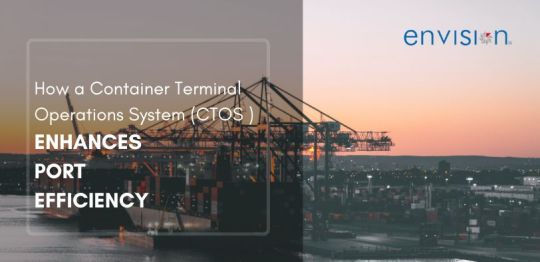
Envision (iPortman) CTOS: The Future of Port Management
Envision’s iPortman CTOS is designed to meet today’s operational needs while future-proofing port efficiency.
Key advantages include:
Modular Architecture: Adaptive module-based deployment for scalable container terminal operating system expansion.
Comprehensive Cargo Handling: Supporting imports, exports, and container freight station (CFS) software integration.
All-in-One Port Management: Unifying all operations under a single platform, including vessel planning and optimization.
Mobile App Support: Enhancing real-time data collection and reducing back-office delays.
Customer Portal Integration: Increasing transparency, stakeholder collaboration, and satisfaction.
Advanced Planning & Optimization: Strengthening efficiency in depot management system (DMS) and yard truck management system deployment.
High-Level Reporting Features: Enabling key information about cargo activities, gate transactions, and performance of automated gate systems.
#container terminal operating system#ai powered port management#ports community management#multi cargo terminal operating system#container shipping#container freight station (cfs) software#terminals#envision enterprise solutions#vessel planning and optimization#ctos#Gctos
0 notes
Text
#ports community management#ai powered port management#container terminal operating system#multi cargo terminal operating system#container shipping#vessel planning and optimization#container freight station (cfs) software#terminals#envision enterprise solutions
0 notes
Text
How Technology is Revolutionizing Depot Management in the Maritime Logistics Industry
Enhancing Operational Effectiveness with Smart Technology
In the current competitive global trade culture, depot management systems (DMS) are developing at a very fast rate to address increased demands. With increasing international trade, container depot software is the key to enhance efficiency, save costs, and speed up cargo handling operations. Automation and robotics have greatly enhanced depot operations by reducing human error, processing times, and improving logistical precision. Artificial intelligence-driven automation, robotic carry vehicles, and automated cranes are spearheading the inland container depot (ICD) automation future, optimizing resource use, and overall operation efficiency.
Data-Driven Decision-Making in Depot Operations
The maritime logistics sector is transforming towards data-driven decision-making to optimize depot management systems (DMS). Through the use of real-time business intelligence and analytics, depot managers can anticipate demand, handle inventory efficiently, and enhance the efficiency of logistics. Predictive analytics based on artificial intelligence streamline the management of container freight stations by enabling the manager to schedule the fleet, optimize equipment allocation, and streamline supply chain functions. Large-scale processing capabilities make for smooth empty container depot management and improve decision-making overall. Efficient depot management facilitates seamless coordination and optimization of resources at the depot.
Cloud Computing and IoT: The Backbone of Smart Depot Management
Cloud computing and Internet of Things (IoT) are transforming contemporary container depot software, providing scalable operations, safe data storage, and remote accessibility. Combining IoT sensors in the depot infrastructure offers real-time cargo tracking, equipment predictive maintenance, and optimized storage conditions. Inland container depot (ICD) automation is facilitated by these developments through the elimination of downtime, avoidance of shipment delays, and enhanced overall efficiency. Container yard optimization through intelligent IoT-based applications helps depot operators measure inventory correctly and ensure smooth flow of logistics. Modern depot management solutions are necessary to keep pace with such developments.
Optimizing Customer Experience through Digital Solutions
A customer-oriented approach is integral to the success of competitiveness in depot management systems (DMS). Advanced Customer Relationship Management (CRM) software supports container depot software by delivering customized services, anticipatory reactions, and extended client relationships. Web-based booking systems, mobile applications, and self-service websites also provide instant access to import/export container logistics. These web-based tools support customers with shipment tracking, real-time notifications, and effortless communication, maintaining operation transparency and dependability. An integrated depot management strategy enhances customer satisfaction.
AI and Chatbots: Revolutionizing Customer Support in Depot Management
Artificial Intelligence (AI) and chatbots are transforming customer support in container freight station (CFS) management software. AI-powered virtual assistants deliver 24/7 customer support, responding to queries in an instant and allowing hassle-free service delivery. AI integration in container depot software reduces the cost of operations as it carries out mundane tasks, allowing human resources to be used on strategic plans. Such developments ensure improved inland container depot (ICD) automation, providing quick responses and improving customer interaction. Efficient depot management solutions further augment service capacity.
Optimizing Logistics with Smart Tracking and Tracing
Real-time tracking and tracing of containers have emerged as essential in streamlining import/export container logistics. IoT-based sensors and GPS-based devices provide accurate tracking details, increasing supply chain visibility. Efficient container yard optimization ensures that every movement within the depot is monitored and recorded, reducing operational inefficiencies. Container drayage management enables depot operators to better coordinate transport schedules, minimizing transit times and maximizing fleet utilization. Strong depot management solutions enable effective tracking and tracing systems.
Future-Proofing Ocean Depots with Smart Technology
The seaborne sector is evolving speedily digitally and smart technology is now a must for contemporary depot management systems (DMS). Automation, cloud computing, Internet of Things, artificial intelligence, and predictive analysis are revolutionizing container depot software, making them efficient and sustainable. Smart automation of inland container depot (ICD) and AI-driven analytics optimize resource allocation and propel container yard optimization. With the incorporation of these technologies, depot operators will have the capability to maintain competitive edge in the new logistics world. Depot management plays an important role in facilitating the integration of technologies smoothly.
Conclusion
In keeping up with competitiveness in maritime logistics, depots must implement advanced technologies that automate operations, raise customer satisfaction levels, and achieve maximum handling of cargo. Installing a powerful depot management system (DMS) saves depot operators money, increases turnaround times, and achieves lasting business success. The merge of container depot software, container freight station management software, and inland container depot automation will play a pivotal role in determining the future of maritime logistics. Utilizing AI, IoT, and cloud computing, the sector can attain unchallenged efficiency in empty container depot management, container tracking and tracing, and container drayage management. Properly implemented depot management is a must for the future of maritime logistics.
#container terminal operating system#ai powered port management#multi cargo terminal operating system#terminals#envision enterprise solutions#depot management system (dms)#vessel planning and optimization
0 notes
Text
0 notes
Text
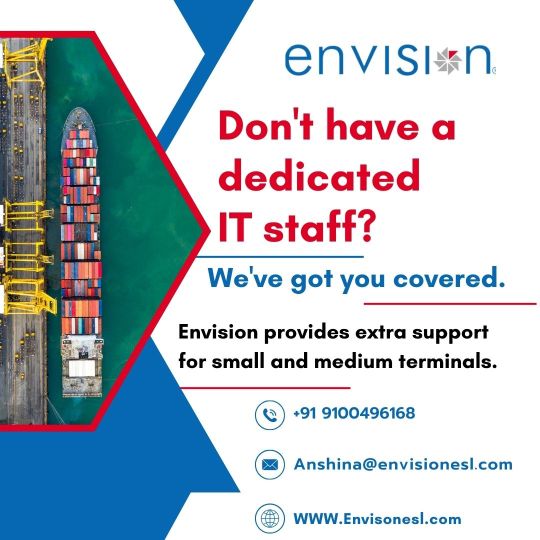
Envision delivers expert IT support for small and medium terminals, helping businesses thrive without the need for a full-time IT team. Discover our services today.
ITSupport #SmallBusiness #TerminalSupport
#terminals#container shipping#ai powered port management#ports community management#vessel planning and optimization#it support#small business
0 notes
Text
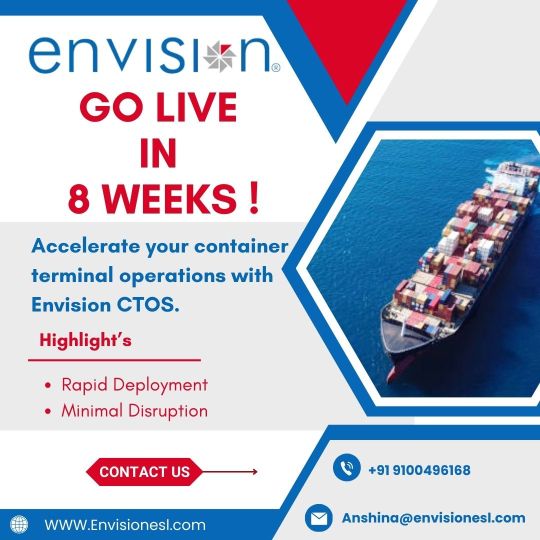
Transform your container terminal operations in just 8 weeks with Envision CTOS. Experience rapid deployment and minimal disruption for maximum efficiency.
#container terminal operating system#container freight station (cfs) software#CTOS#RapidDeployment#PortTech#multi cargo terminal operating system#ports community management#operations
0 notes
Text
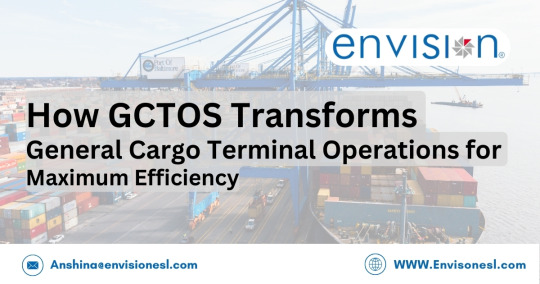
How Envision iPortman GCTOS Automates Terminal Operations
New-age marine terminal operators are under pressure to increase efficiency, comply with safety standards, and maximize the use of resources. There has to be a digital-first mentality for monitoring, controlling, and optimizing logistics in real time.
Imagine iPortman is the next-generation multi-cargo terminal operating system that is designed to be an end-to-end solution to inject intelligence into terminal operations, from order to invoice (O2I). It accommodates multi-purpose terminal automation and ensures high-efficiency port operations.
#container freight station (cfs) software#container shipping#container terminal operating system#multi cargo terminal operating system#terminals#ports community management#ai powered port management#smart ports#envision enterprise solutions#iportman
0 notes
Text
How GCTOS Transforms General Cargo Terminal Operations for Maximum Efficiency
The Effects of Trade Expansion on Cargo Terminal Operations
As world trade liberalization and economic growth proceed, the volumes of shipping cargoes have skyrocketed around the globe. There are diverse methods of storage, loading, unloading, and securing for a variety of ships carrying general cargoes. As commodities are demanding more goods, economic development and growth are escalating. In shipping, commodities referred to as general cargo are stored in single compartments. Such types of general cargoes are bulk, break bulk, and liquid bulk.

Key Functions of General Cargo Terminal Operating Systems (GCTOS)
Like a Container Terminal Operating System (CTOS), a General Cargo Terminal Operating System (GCTOS) makes terminal operations smooth through handling:
Efficient Loading and Discharging of cargo
Gate Operations and Truck Management for efficient logistics
Terminal Inventory Management for monitoring cargo movement
Equipment and Gear Productivity to maximize resource use
Yard Utilization to maximize space
A multi-cargo terminal operating system is essential for handling diverse cargo efficiently. The dry bulk TOS and wet bulk TOS optimize cargo movement in bulk segments. Meanwhile, a Ro-Ro TOS is vital for efficient roll-on/roll-off cargo operations. Implementing a universal cargo TOS ensures seamless integration across different cargo types.
Why is General Cargo TOS Important for Contemporary Ports?
Increased global trade and bigger ships make higher-performing terminals with streamlined operations necessary. With increasing competition among ports, terminal operators are now concentrating on improving throughput and operating efficiency.
A General Cargo TOS takes advantage of the latest IT solutions to maximize reliability and balance transaction loads at peak hours. The system is flexible and scalable, minimizing the Total Cost of Ownership (TCO) for terminal operators. In light of the need for efficiency, the proper choice of multi-purpose terminal automation is important to achieve high performance.
Challenges in General Cargo Handling & How GCTOS Solves Them
More than 90% of world cargo by volume and 70% by value are carried on maritime routes. Unlike CTOS, GCTOS has no standardized electronic data interchange system, resulting in complicated cargo manifest handling. Identification of cargo is frequently determined by physical properties such as color and nature, making stevedore operations complicated. Cargo can also require consolidation, repackaging, or sequencing according to FIFO or LIFO principles.
An effective GCTOS simplifies general cargo operations by:
Enhancing bulk cargo handling software for better tracking
Optimizing Equipment Deployment to minimize demurrage charges
Capturing All Billable Activities for accurate invoicing
Maximizing Throughput and Storage to increase efficiency and profitability
Reducing Vessel Turnaround & Dwell Time for seamless operations
Unlike containerized cargo, general cargo has higher exposure to environmental factors, making warehouse management and operational precision critical. Implementing cargo terminal optimization software improves overall operational visibility and efficiency.
How Envision iPortman GCTOS Automates Terminal Operations
New-age marine terminal operators are under pressure to increase efficiency, comply with safety standards, and maximize the use of resources. There has to be a digital-first mentality for monitoring, controlling, and optimizing logistics in real time.
Imagine iPortman is the next-generation multi-cargo terminal operating system that is designed to be an end-to-end solution to inject intelligence into terminal operations, from order to invoice (O2I). It accommodates multi-purpose terminal automation and ensures high-efficiency port operations.
Key Features of iPortman GCTOS
Vessel Management for streamlined docking and unloading
Berth Management for optimizing the utilization of port space
Service Management for enhancing workflow efficiency
Break-bulk cargo management for efficient handling of non-containerized shipments
Cargo Documentation & Operations for import/export monitoring
Yard & Warehouse Operations for organized cargo management
Gate Operations to make entry and exit processes more efficient
Tariff & Invoicing for correct financial management
Seamless Integrations with third-party applications
Reports & Dashboards for data-driven decision-making
Mobility Solutions for real-time monitoring and control on the go
User & System Administration for greater security
A robust car terminal TOS is also incorporated into iPortman GCTOS, ensuring seamless tracking of automotive logistics. Additionally, bulk cargo handling software enhances efficiency in managing loose cargo types.
The Competitive Edge of iPortman GCTOS
iPortman GCTOS provides real-time berth status monitoring, vessel berthing/unberthing recording, and sophisticated cargo delivery processes by rail, road, barge, or conveyor.
A sophisticated tariff module for elastic pricing by transport mode is also available.
Integration Capabilities: Client-configurable positioning detection system with client-specific adaptations.
Security & Mobility: Secure access to encrypted data in both online and offline environments.
User Management: Complete management over audit logs and change logs.
Conclusion
Imagine iPortman GCTOS is made to optimize port efficiency, minimize operating expenses, and enhance cargo handling productivity. With global trade picking up speed, an investment in a sophisticated multi-cargo terminal operating system is no longer a choice but a necessity.
By leveraging cargo terminal optimization software, ports can streamline their operations and achieve higher efficiency. The role of break-bulk cargo management, dry bulk TOS, and wet bulk TOS cannot be understated in modern terminal automation.
To learn more about how iPortman GCTOS can revolutionize your terminal, reach out to Envision now!
#terminals#container freight station (cfs) software#container shipping#logistics#maritime#multi cargo terminal operating system#container terminal operating system#ports community management#ai powered port management#envision enterprise solutions#iportman
0 notes
Text
The key benefits of CTOS implementation
Reduced Vessel Turnaround Time: Faster cargo handling increases port calls and enhances throughput.
Revenue Optimization: Efficient asset utilization and automated invoice processing improve financial performance.
Lower Operating Costs: Reducing manual operations and leveraging container terminal automation minimizes expenses.
Maximized Resource Utilization: Optimizing asset allocation across yard truck management systems and depot management system (DMS).
Enhanced Transparency & Collaboration: Real-time reporting strengthens stakeholder communication, improving customer satisfaction.
Envision (iPortman) CTOS: The Future of Port Management
Envision’s iPortman CTOS is designed to meet today’s operational needs while future-proofing port efficiency.
Key advantages include:
Modular Architecture: Adaptive module-based deployment for scalable container terminal operating system expansion.
Comprehensive Cargo Handling: Supporting imports, exports, and container freight station (CFS) software integration.
All-in-One Port Management: Unifying all operations under a single platform, including vessel planning and optimization.
Mobile App Support: Enhancing real-time data collection and reducing back-office delays.
Customer Portal Integration: Increasing transparency, stakeholder collaboration, and satisfaction.
Advanced Planning & Optimization: Strengthening efficiency in depot management system (DMS) and yard truck management system deployment.
High-Level Reporting Features: Enabling key information about cargo activities, gate transactions, and performance of automated gate systems.
#container freight station (cfs) software#container#container terminal operating system#multi cargo terminal operating system#ai powered port management#ports community management
0 notes
Text
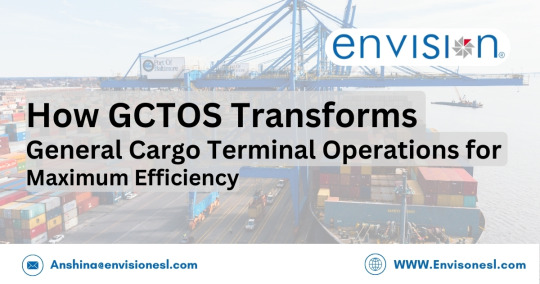
As world trade liberalization and economic growth proceed, the volumes of shipping cargoes have skyrocketed around the globe. There are diverse methods of storage, loading, unloading, and securing for a variety of ships carrying general cargoes. As commodities are demanding more goods, economic development and growth are escalating. In shipping, commodities referred to as general cargo are stored in single compartments. Such types of general cargoes are bulk, break bulk, and liquid bulk.
Like a Container Terminal Operating System (CTOS), a General Cargo Terminal Operating System (GCTOS) makes terminal operations smooth through handling
#terminals#container terminal operating system#ai powered port management#vessel planning and optimization
0 notes
Text
How a Container Terminal Operations System (CTOS) Enhances Port Efficiency
Table of Contents
Introduction
The Evolution of Vessel and Terminal Operations
The Role of a Container Terminal Operating System (CTOS) in Efficiency
Key Factors Influencing Port Efficiency
The Strategic Importance of a CTOS
Envision (iPortman) CTOS: The Future of Port Management
Conclusion
The Evolution of Vessel and Terminal Operations
With growing international freight volumes, freighters are increasingly larger and quicker. Shippers require lower shipping costs, but shipping companies look to decrease the cost of shipping per unit. Reducing vessel turnaround at ports has emerged as an extremely effective measure of cost-saving, and therefore terminal operators have turned to the most advanced container terminal automation technology. Hence, it is necessary to invest in new container terminal operating systems (CTOS) and new infrastructure for improved efficiency as well as dock reduction time.
The Role of a Container Terminal Operating System (CTOS) in Efficiency
With the highly competitive environment, effective terminal operations are essential to retain a competitive advantage. Though capacity expansion of the terminal has been the focus, terminal management software tends to get neglected. A robust container terminal operating system (CTOS) is essential to automate processes and improve service levels.
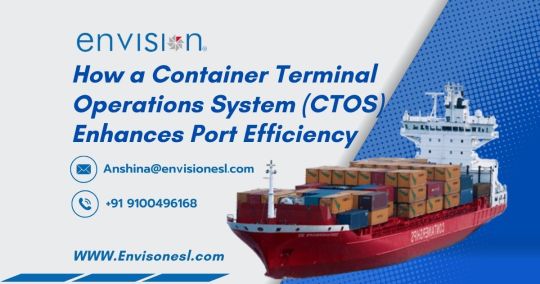
The primary features of a CTOS are:
Optimized Container Movement Management: Accurate placement of containers within the terminal.
Automated Loading/Unloading Scheduling: Optimizing the utilization of container yard management systems based on real-time shipping data.
Seamless Multi-Modal Integration: Enabling unproblematic road, rail, and sea transportation mode transfers through automated gate system support.
Improved Communication: Providing stakeholders with precise container tracking software updates.
Key Factors Influencing Port Efficiency
Container terminals play a critical role in international logistics by managing cargo handling and intermodal transfers. Several factors impact port efficiency, including:
Yard Size & Layout: Directly influencing storage capacity and movement optimization.
Maritime, Road, and Rail Connectivity: Ensuring efficient cargo transfers between transport networks.
Advanced Machinery: Boosting operational productivity and enhancing automated gate system performance.
Container Terminal Operating System (CTOS): A foundational tool that streamlines operations, from vessel planning and optimization to yard truck management system implementation.
The Strategic Importance of a CTOS
Maximizing efficiency and minimizing costs are key issues for terminal operators. Container terminal operating system (CTOS) simplifies container handling, making cargo flow smooth.
The key benefits of CTOS implementation include:
Reduced Vessel Turnaround Time: Faster cargo handling increases port calls and enhances throughput.
Revenue Optimization: Efficient asset utilization and automated invoice processing improve financial performance.
Lower Operating Costs: Reducing manual operations and leveraging container terminal automation minimizes expenses.
Maximized Resource Utilization: Optimizing asset allocation across yard truck management systems and depot management system (DMS).
Enhanced Transparency & Collaboration: Real-time reporting strengthens stakeholder communication, improving customer satisfaction.
Envision (iPortman) CTOS: The Future of Port Management
Envision’s iPortman CTOS is designed to meet today’s operational needs while future-proofing port efficiency.
Key advantages include:
Modular Architecture: Adaptive module-based deployment for scalable container terminal operating system expansion.
Comprehensive Cargo Handling: Supporting imports, exports, and container freight station software (CFS) integration.
All-in-One Port Management: Unifying all operations under a single platform, including vessel planning and optimization.
Mobile App Support: Enhancing real-time data collection and reducing back-office delays.
Customer Portal Integration: Increasing transparency, stakeholder collaboration, and satisfaction.
Advanced Planning & Optimization: Strengthening efficiency in depot management system (DMS) and yard truck management system deployment.
High-Level Reporting Features: Enabling key information about cargo activities, gate transactions, and performance of automated gate systems.
Conclusion
The use of an advanced container terminal operating system (CTOS) is necessary for maximizing port efficiency, lowering costs, and fueling revenue growth. Envision’s iPortman CTOS presents a comprehensive, future-proof solution that enhances transparency, productivity, and terminal operations. In today’s competitive global logistics environment, investing in a sophisticated CTOS, along with container yard management system and container freight station (CFS) software, is no longer optional—it’s a necessity.
#container terminal operating system#container terminal automation#container tracking software#vessel planning and optimization#depot management system (DMS)#container freight station (CFS) software#AI-powered port management#multi-cargo terminal operating system
1 note
·
View note